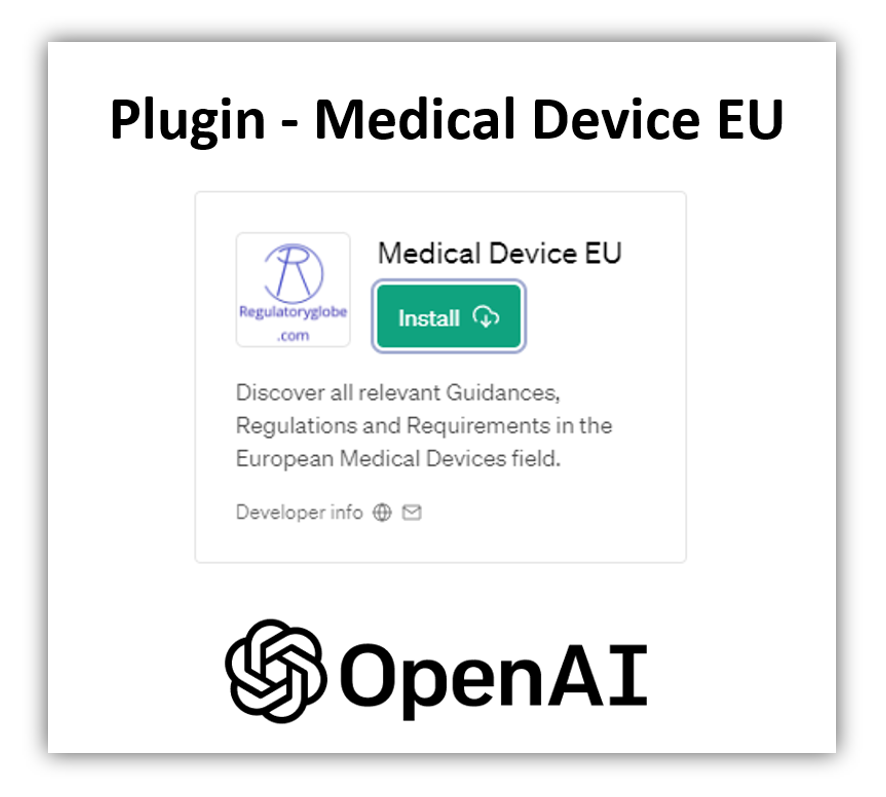
Medical Device Plugin for ChatGPT
The world’s first Medical Device Regulation Plugin on OpenAI for ChatGPT
The goal of the Medical Device EU plugin is to provide users with accurate and up-to-date information related to European Regulations such as MDR and IVDR in the medical device sector, assisting stakeholders in navigating the complex regulatory landscape and supporting compliance with EU regulations. The plugin aims to offer a focused, reliable, and efficient source of knowledge for all topics related to medical devices in the EU.

What is ChatGPT?
ChatGPT is an artificial intelligence-driven chatbot developed by OpenAI. It is designed to generate human-like text based on the context provided and past conversations, making it capable of engaging in text-based interactions with users in a way that mimics human conversation. Specifically, ChatGPT employs advanced machine learning technologies to comprehend the context of a conversation and generate responses that are both natural-sounding and relevant to the discussion. By utilizing AI, ChatGPT can engage in extremely realistic and human-like text conversations with its users. This AI-powered chatbot functions by receiving a question or prompt, understanding the context through machine learning algorithms, and generating appropriate responses accordingly.
Why ChatGPT Plugins can be so useful?
Plugins on ChatGPT greatly improve how the platform works, making it more useful and enjoyable for users. They add special features that make ChatGPT more flexible, catering to different needs, whether personal or related to specific industries. For instance, they can automate routine tasks, saving time and reducing mistakes, which boosts overall productivity. They also provide real-time updates from external sources, which is essential in fields like regulatory affairs to stay current with the latest regulations. Users can tailor their ChatGPT experience through plugins, making it easier to use. Plugins support better decision-making by providing extra data and analysis. They also encourage teamwork by enabling information sharing and project management directly within ChatGPT. For those keen on learning, plugins serve as educational tools, offering resources and interactive learning experiences. As organizations grow, plugins help ChatGPT adapt to new needs, and can also connect ChatGPT to other software systems for a smoother workflow.
ChatGPT Plus users have via Bing access to the internet. Why a Plugin like the Medical Device EU Plugin is still better and more accurate?
ChatGPT, while capable of internet access, operates on a general understanding acquired during training, which may not always reflect the most accurate or up-to-date information, especially in specialized fields like medical device regulation. On the other hand, plugins are specifically designed and trained for particular use cases, ensuring they provide precise and current information. In the case of medical device regulations, this plugin is tailored to access reliable sources, delivering accurate and up-to-date regulatory data. This focused expertise makes plugins a more reliable choice for professionals seeking trustworthy and specialized information, enhancing the accuracy and efficacy of their work in regulatory compliance.
What is the use case of the Medical Device EU plugin?
The Medical Device EU plugin is designed to assist with questions and information related to European Regulations for medical devices. Here are some of the primary use cases for the Medical Device EU plugin:
- European Regulation Information: The plugin provides details about the Medical Device Regulation (MDR 2017/745), In Vitro Diagnostic Regulation (IVDR 2017/746), and other related regulations.
- Classification and Compliance: It can help users understand the classification rules for medical devices, risk classes, and the necessary steps for compliance.
- Standards and Guidelines: The plugin offers information on ISO standards, companion documents, guidelines, and other regulatory affairs related to medical devices in the EU.
- Technical Documentation: Users can get insights about technical files, technical documentation, and other required documents for regulatory compliance.
- Economic Operators and Roles: The plugin provides details about the roles and responsibilities of various economic operators like manufacturers, distributors, authorized representatives, etc.
- Unique Device Identification (UDI): It offers information about UDI, Basic UDI, UDI-DI, and other related topics.
- Notified Bodies: Users can get details about notified bodies, their roles, and their significance in the regulatory landscape.
- Transition Provisions: The plugin can provide insights about transition periods, extended transitions, and other transitional provisions for medical devices.
- Cybersecurity and Software: It can assist with questions related to software as a medical device (SaMD), cybersecurity requirements, and other software-related regulations.
- News and Updates: Users can stay updated with the latest medical device news, regulatory changes, and other relevant updates.
In summary, the Medical Device EU plugin is a comprehensive tool designed to simplify the regulatory landscape for medical devices in the European Union. It’s a valuable resource for manufacturers, distributors, regulatory affairs professionals, and anyone involved in the medical device industry in the EU.
What are the advantages of this plugin?
- Focused Expertise: The plugin provides specific information about European medical device regulations, ensuring that users receive accurate and relevant answers to their queries.
- Up-to-date Information: Given the dynamic nature of regulations, having a dedicated plugin ensures that users get the most recent and relevant regulatory information.
- Efficiency: Instead of sifting through vast amounts of general information, users can quickly get answers tailored to the medical device regulatory landscape in the EU.
- Comprehensive Coverage: The plugin covers a wide range of topics, from specific regulations like MDR and IVDR to broader topics like classification rules, standards, and technical documentation.
- Guidance: For manufacturers, distributors, and other stakeholders in the medical device industry, the plugin can serve as a guide, helping them navigate the complex regulatory landscape.
- Reliability: With a dedicated focus on European medical device regulations, the plugin can offer more reliable and accurate information compared to general search or generic responses.
- Ease of Use: Users can seamlessly integrate their queries within the ChatGPT environment without needing to switch to different platforms or tools.
- Continuous Learning: As more users interact with the plugin and ask questions, it can potentially improve over time, offering even better and more refined answers.
- Cost-Effective: For businesses and individuals, accessing regulatory information through the plugin can be more cost-effective than hiring consultants or spending hours on research.
- Safety and Compliance: By providing accurate regulatory information, the plugin can assist manufacturers and other stakeholders in ensuring that their products are safe and compliant with EU regulations.
How to get access:
- Log in to your ChatGPT Plus account.
- Proceed to the plugins section and search for “Medical Device EU” plugin.
- Click on ‘Install’ to assimilate the plugin to your ChatGPT account.
How to use:
How to use the Medical Device EU Plugin for ChatGPT to get highly valuable responses back. Here are 10 points you must follow:
1. Be Clear and Specific:
Instead of: “Tell me about that EU medical thing.”
Try: “Can you explain the main objectives of the EU MDR 2017/745?”
2. Provide Context:
Instead of: “What changes were made?”
Try: “What are the key differences between the EU MDR 2017/745 and its predecessor, the Medical Devices Directive (MDD)?”
3. Use Complete Sentences:
Instead of: “EU MDR classification?”
Try: “How are medical devices classified under the EU MDR 2017/745?”
4. Avoid Ambiguity:
Instead of: “How to comply?”
Try: “What are the steps manufacturers should take to ensure compliance with the EU MDR 2017/745?”
5. Explicitly State Your Desired Format:
If you want a summary, ask for it: “Can you give me a brief summary of the post-market surveillance requirements under EU MDR 2017/745?”
If you want a detailed answer, specify that: “Can you provide a detailed explanation of the Post-Market Surveillance Report (PSUR) as outlined in the EU MDR 2017/745?”
6. Limit Multiple Questions:
Instead of: “What is the EU MDR, how does it affect manufacturers, and what are its main components?”
Try breaking it down: “What is the EU MDR 2017/745?” followed by “How does the EU MDR 2017/745 affect medical device manufacturers?” and then “What are the main components of the EU MDR 2017/745?”
7. Use Proper Terminology (if known):
Instead of: “That EU rule for medical stuff.”
Try: “The Medical Device Regulation (EU MDR 2017/745).”
8. Avoid Overly Broad Questions:
Instead of: “Tell me everything about EU medical regulations.”
Try: “Can you explain the key requirements for medical device labeling under the EU MDR 2017/745?”
9. Be Patient and Willing to Reframe:
If the first query doesn’t yield the desired answer, consider rephrasing or providing additional context.
10. Review and Revise:
Before submitting, review your query to ensure it’s clear and likely to yield the information you’re seeking.
By tailoring your queries to the specific context you’re more likely to receive accurate and relevant information in response.
What’s next?:
Something big is on the horizon at Regulatory Globe! Subscribe to our next exciting launch and be the first to explore what’s coming. Don’t miss out, hit ‘Subscribe’ and stay ahead in the game! Subscribe here
Summary:
Our Medical Device EU plugin, integrated with ChatGPT, simplifies access to European Medical Device Regulations. Through a chat-based interaction, it provides updated compliance standards, saving you the trouble of manual searches. It makes navigating complex regulatory information intuitive, offering quick answers to your queries. This user-friendly chat interface streamlines decision-making and enhances compliance. Overall, it’s a hassle-free solution for regulatory guidance in the European Medical Device sector.
Disclaimer:
Please note that both the Medical Device EU plugin and ChatGPT are currently in a beta phase. All information provided is for informational purposes only and is not legally binding. It’s essential to consult with a medical device expert or regulatory professional to ensure accurate and compliant decision-making specific to your needs.


